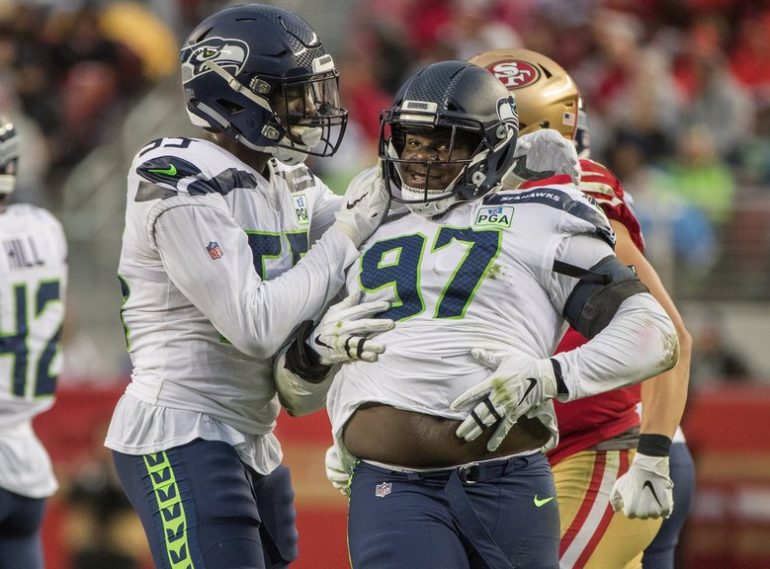Pete Carroll’s Seahawks have been known for their defense as much as anything through his tenure. The reality is it has been a while since Seattle had a defense that intimidated anyone. With Frank Clark leaving, Jarran Reed suspended for six games, and first-round pick L.J. Collier out indefinitely, there is real concern about just how handcuffed the Seahawks pass rush could be, and the secondary remains a question mark. The team is left with a collection of defensive linemen better suited to stop the run and an excellent linebacking corps. There might be a way for Seattle to become a more efficient defense with the personnel they have, even if they remain well short of their former levels of dominance.
The three primary defensive tackles during the first six weeks of the season will likely be Poona Ford, Al Woods, and Earl Mitchell. None are known for rushing the passer, but each can eat space and disrupt the running game. Bobby Wagner, K.J. Wright and Mychal Kendricks should represent a major step forward for a linebacking crew that only had Wright and Kendricks for a handful of games last season and often ran out the likes of Austin Calitro and Barkevious Mingo.
As fondly as many Seahawks fans remember Clark and Reed piling up sacks last season, they may forget just how awful the team was at defending the run.

Neutral script is defined differently by different folks. What I looked at here were situations where the Seahawks were within one score (+/- 8 points), and were within the first three quarters of the game. That helps get a better feel for how opponents were attacking the Seahawks when the game was still in question and they were not in desperation mode in the final quarter.
The chart above shows that the Seahawks defense allowed a cringy 5.03 yards per carry in those situations last season. That ranked 25th in the NFL. The pass defense was not awesome (more on that later), but they still ranked 19th in the NFL in yards per attempt in these neutral script situations.
You can also see just how far the team has fallen off in this area. Even the middling 2017 defense was more than a yard per carry better in defending the run in these moments.
In all, the Seahawks gave up a total of 1,811 rush yards and 4.9 yards per carry (not limited to neutral script). That YPC number ranked 30th in the NFL. Had Seattle simply surrendered the same YPC they gave up in 2017 (4.0 instead of 4.9) on the same 366 opponent rush attempts, they would have allowed 334 fewer yards last season. If they had managed the 3.4 YPC they achieved in 2016, that number becomes 576 fewer yards.
That means the Seahawks defense would have ranked 6th in the NFL last season if they did nothing but improve their run defense to match the 2016 YPC numbers, and would have ranked 8th if they matched the 2016 performance.
I can already hear a certain contingent of Seahawks fans grabbing their pitchforks and troll torches to shout down anything and anyone who claims there is value in improving a part of the game related to running the football.
The truth is, I’d prefer to have a convincing story to tell about why the Seahawks pass defense will be much better due either to improved coverage in the secondary or a better pass rush. Both of those things are possible, but far from likely at this point. We can say pass defense matters more all we want, but if the team’s best chance to improve their efficiency is to be better when opponents do choose to run, so be it.
It was not just about pure rushing yards. Seattle was quite bad at limiting explosive plays last season. A lot of that regression came in run defense.

More than one out of every ten opponent rush attempts went for more than 12 yards. Yikes. That was nearly three times the rate they achieved in 2016.
Explosive rushes generally come from poor run fits behind the line of scrimmage. That starts with the linebackers, and extends to the safeties and corners. Tedric Thompson was especially poor at closing down runs that Earl Thomas used to snuff out. Thompson may be back in the same spot again. Guys like Kendricks and Wright are far more likely to keep runners in front of them then the guys the team ran out there last season, which should help them rely less on Thompson to be the last line of defense.
Seattle ranked 21st in explosive rushes allowed last year, which was the worst ranking of the Carroll era. The previous worst was 14th in 2012 and 2013.
If the Seahawks had managed to cut their explosive rush rate in half to 5.5% —which they matched or bettered three of the previous four seasons—they would have allowed just 20 explosive rushes and ranked 3rd in the NFL.
A guy like Ford has a chance to be a real difference maker against the run. He had the highest grade in run defense of all defensive tackles last year and the highest rookie grade (91.7) since 2006, per ProFootballFocus.com. Woods had a 89.7 run grade from PFF in 2017 for the Colts, which ranked 7th in the NFL, just behind Linval Joseph of the Vikings. Reed will be back after six games and was among the ten best defensive tackles at stuffing the run last season.
It might not be sexy or the most desirable way to improve, but there is a believable path to Seattle becoming a much better run defense in 2019. If the pass coverage can improve even slightly, or at least not decline, the overall defense could step forward.
